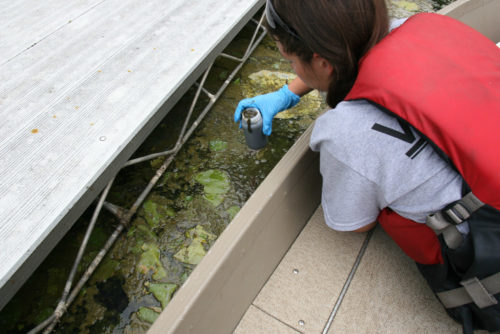Stormwater runoff carries a wide variety of pollutants from our lands into our rivers, lakes and wetlands. In urban areas (like the MWMO watershed), common pollutants include things like bacteria from animal waste, nutrients from leaves and fertilizer, chloride from road salt, and sediment (i.e., dirt).

These pollutants are cause for concern for different reasons: some pose a direct threat to human health, while others primarily harm animals or plants. All of them, however, create serious challenges for our ecosystems — and ultimately, for our way of life.
Take chloride, for example. This chemical, which comes from the road salt we apply on our streets and highways in the winter, is toxic to fish, extremely difficult to remove, and accumulates over time. In fact, a recent study found that by 2050, many Twin Cities metro area lakes will contain so much chloride that they may no longer be able to support native fish and plants.
It’s important to remember that pollutants and their impacts are closely linked to land use — that is, how we develop our lands and use them for different purposes (i.e., industry, agriculture, commerce, residences, etc.). In rural areas, agricultural land use leads to more pollution from fertilizer chemicals (phosphorus and nitrogen) and sediment (from erosion), whereas in urban areas chloride is a much bigger problem.
Types of Pollutants
The MWMO monitors pollutants and other water quality indicators both in the Mississippi River and the local stormsewer systems in our watershed. We primarily monitor pollutants for which there are established water quality standards. There are also other, newer pollutants of emerging concern, such as microplastics and pharmaceuticals, which are not currently regulated under any state or federal laws.
By law, all rivers, lakes and other waterbodies must be safe for certain designated uses. For example, in the MWMO watershed, the Mississippi River must be suitable as a source of drinking water as well as for activities like fishing and swimming. When a waterbody does not meet approved water quality standards for a certain pollutant, it is called “impaired.” The law requires that impaired waterbodies be monitored and that a TMDL plan be implemented to improve its water quality.
Bacteria
Many bacteria can be harmful to human health, causing sickness or even death if ingested. This is especially true of bacteria that originate in human and animal feces. When monitoring waterbodies, the MWMO and other public agencies in Minnesota test for one specific kind of bacteria, called Escherichia coli (or E. coli for short), because it’s an “indicator organism” that denotes the presence of fecal waste.
E. coli is present in both human and animal waste (including pets as well as wildlife). Stormwater washes it off the land and into the storm drains; from there, it travels untreated into the Mississippi River or another body of water. For this reason, we generally advise residents to avoid swimming in the Mississippi River within 72 hours after a rainstorm.
Some part of the Mississippi River are listed as impaired for E. coli, meaning they do not meet state water quality standards (at least part of the time).
Chloride
Chloride is a chemical found in road salt and other deicing chemicals commonly used to remove snow and ice from roads, parking lots and sidewalks in the winter. Although these chemicals have been in use since the 1940s, their use skyrocketed in the late 20th Century, inundating many waterways with chloride (particularly in urban areas). Water softeners and dust control chemicals on rural roadways are also sources of chloride contamination.
Chloride is toxic to freshwater fish and other animals, as well as to aquatic plants. Once in the water, it is extremely difficult to remove. (Reverse osmosis can remove chloride from water, but this method is extremely expensive.) With each passing winter, chloride levels in our waterbodies continue to accumulate. As mentioned above, researchers predict that by 2050 many Twin Cities metro area lakes may no longer be able to support native fish and plants due to chloride contamination.
Nutrients

Nutrients like phosphorus and nitrogen are common elements in the environment and found in organic material. While they are essential for plant growth and health, in excess they can be extremely harmful to water quality. Stormwater runoff carries excess nutrients into rivers, lakes and wetlands via local stormsewer systems.
In Minnesota, the main source of both phosphorus and nitrate (i.e., nitrogen) pollution is agricultural runoff. However, urban runoff also contributes to the problem. Phosphorus and Nitrogen are present in leaves, grass clippings and other yard waste. Pet waste and fertilizer are also potent sources of nutrients. Like other pollutants, these excess nutrients enter waterbodies via the local stormsewer systems.
Phosphorus harms waterbodies by feeding algae and choking out oxygen. Excess nitrate threatens human health and aquatic life, and is a primary contributor to the Gulf of Mexico “dead zone.”
Sediment
Sediment (i.e., “dirt”) includes tiny particles of soil, silt, clay, sand and/or other organic materials that are suspended in the water. Suspended solids make the water murky, which harms aquatic plants and habitat for fish and other wildlife. These solids also absorb heat from the sun, making our surface waters warmer.
Murky water prevents natural vegetation from growing and prevents animals from seeing their food. Sediment can also build up in storm drains, which increases the potential for flooding.
Eroding riverbanks, agricultural runoff and improperly managed construction sites are common sources of sediment pollution. According to the State of the River Report, within the Twin Cities metro area, about 75 percent of sediment in the Mississippi River comes from the Minnesota River basin, where eroding river bluffs, stream banks and farm fields are the primary sources of pollution.
Other Pollutants
Mercury is a naturally occurring element that is toxic to humans and animals. It affects human nervous systems, particularly of young children and fetuses. Learn more on the MPCA website.
Pollutants of Emerging Concern include a wide variety of unregulated chemicals, such as pharmaceuticals, fragrances, fire retardants, and insecticides. Learn more on the MPCA website.
Oil, grease, toxic chemicals and heavy metals are other pollutants that are commonly found in urban environments.
Trash is not a chemical pollutant, is harmful to wildlife when they consume it.
Resources
- Water Pollutants and Stressors — Minnesota Pollution Control Agency
- Groundwater and Drinking Water Protection — Minnesota Department of Agriculture
- Water and Health — Minnesota Department of Health
- State of the River Report — Friends of the Mississippi River and the U.S. National Park Service